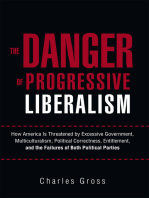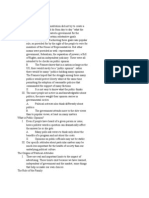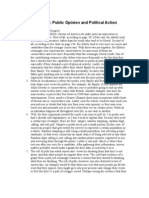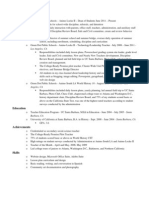9 - CH 6 Part 2
Uploaded by
Mr. Chardon9 - CH 6 Part 2
Uploaded by
Mr. Chardon#9 Ch.
6, Part 2
Purpose: To help you understand the chapter
Name_____________ Date______________ Per#______________
Directions: Read the following to get a better understanding og the chapter.
WHAT AMERICANS VALUE: POLITICAL IDEOLOGIES Generally, Americans tend to identify themselves as conservatives more than moderates or liberalswhich helps to account for the relatively limited scope of government in the United States. But who identifies as a liberal or conservative often varies according to age, gender, race and socioeconomic status. Groups with political clout tend to be more conservative than groups whose members have often been shut out from the halls of political power. Women are not a minority group, making up about 54 percent of the population, but they have nevertheless been politically and economically disadvantaged. Compared to men, women are more likely to support spending on social services and to oppose the higher levels of military spending, which conservatives typically advocate. This ideological difference between men and women has led to the gender gap, which refers to the regular pattern by which women are more likely to support Democratic candidates. Ideological thinking is not widespread in the American public, nor are people necessarily consistent in their attitudes. For most people, the terms liberal and conservative are not as important as they are for political elites. Thus, the authors of the classic study The American Voter(Angus Campbell, et al.) concluded that to speak of election results as indicating a movement of the public to either the "left" or "right" is a misnomer because most voters do not think in such terms. Furthermore, those who do think in ideological terms are actually the least likely to shift from one election to the next. The relatively small percentage of voters who made up their minds in the last couple of days of the Bush-Gore campaign in 2000 were far more concerned with integrity and competence than ideology. HOW AMERICANS PARTICIPATE IN POLITICS Political participation encompasses the many activities used by citizens to influence the selection of political leaders or the policies they pursue. Paradoxically, the United States has a participatory political culture; but only 51 percent of Americans voted in the 2000 presidential election, and only 39 percent voted in the 2002 mid-term elections. Turnout in local elections is even lower. Political scientists generally distinguish between two broad types of participation, conventional and unconventional. Conventional participation includes many widely accepted modes of influencing government, such as voting, trying to persuade others, ringing doorbells for a petition, and running for office. Although the decline of voter turnout is a development Americans should rightly be concerned about, a broader look at political participation reveals some positive developments for participatory democracy. Unconventional participationincludes activities that are often dramatic, such as protesting, civil disobedience, and even violence. Protest is a form of political participation designed to achieve policy change through dramatic and unconventional tactics, and protests today are often orchestrated to provide television cameras with vivid images. Throughout American history, individuals and groups have sometimes used civil disobedience, in which they consciously break laws that they think are unjust. Nonviolent civil disobedience was one of the most effective techniques of the civil rights movement in the American South. Although political participation can also be violent (as in some of the Vietnam War protests of the 1960s), perhaps the best indicator of how well socialized Americans are to democracy is that protest typically is aimed at getting the attention of government rather than at overthrowing it.
In the United States, participation is a class-biased activity, with citizens of higher socioeconomic status participating more than others. Minority groups like Hispanics and African Americans are below average in terms of political participation. However, the participation differences between these groups and the national average have been declining. When blacks, Hispanics, and whites of equal incomes and educations are compared, it is the minorities who participate more in politics. UNDERSTANDING PUBLIC OPINION AND POLITICAL ACTION While more people today think the government is too big rather than too small, a plurality has consistently called for spending on programs like education, healthcare, aid to big cities, protecting the environment, and fighting crime. Many political scientists have looked at these contradictory findings and concluded that Americans are ideological conservatives but operational liberals. Americans often take for granted the opportunity to replace our leaders at the next election. Even if they are only voting according to the nature of the times, voters are being heard-which holds elected officials accountable for their actions.
1. Explain the main differences between a liberal and a conservative.
2. How do liberals and conservative differ in their opinion on the scope of government?
3. When looking at equal social classes, what are the findings about participation among different races?
You might also like
- Democracy in America?: What Has Gone Wrong and What We Can Do About ItFrom EverandDemocracy in America?: What Has Gone Wrong and What We Can Do About It5/5 (1)
- The Echo Machine: How Right-Wing Extremism Created a Post-Truth AmericaFrom EverandThe Echo Machine: How Right-Wing Extremism Created a Post-Truth AmericaNo ratings yet
- The Parties Versus the People: How to Turn Republicans and Democrats Into AmericansFrom EverandThe Parties Versus the People: How to Turn Republicans and Democrats Into Americans5/5 (10)
- Political Participation: Activating The Popular Will: Chapter OutlineNo ratings yetPolitical Participation: Activating The Popular Will: Chapter Outline12 pages
- Pol_Socio_W7_-_Political_Participation_and_Voting_2019No ratings yetPol_Socio_W7_-_Political_Participation_and_Voting_201934 pages
- Beyond Liberal and Conservative: Reassessing the Political SpectrumFrom EverandBeyond Liberal and Conservative: Reassessing the Political SpectrumNo ratings yet
- American Political Attitudes and Participation (Ushistory - Org)No ratings yetAmerican Political Attitudes and Participation (Ushistory - Org)1 page
- American Political Culture, Public Opinion and IdeologyNo ratings yetAmerican Political Culture, Public Opinion and Ideology54 pages
- The Politics of Voter Suppression: Defending and Expanding Americans' Right to VoteFrom EverandThe Politics of Voter Suppression: Defending and Expanding Americans' Right to Vote4/5 (4)
- Partisan Nation: The Dangerous New Logic of American Politics in a Nationalized EraFrom EverandPartisan Nation: The Dangerous New Logic of American Politics in a Nationalized EraNo ratings yet
- The Danger of Progressive Liberalism: How America Is Threatened by Excessive Government, Multiculturalism, Political Correctness, Entitlement, and the Failures of Both Political PartiesFrom EverandThe Danger of Progressive Liberalism: How America Is Threatened by Excessive Government, Multiculturalism, Political Correctness, Entitlement, and the Failures of Both Political PartiesNo ratings yet
- Dynamic Democracy: Public Opinion, Elections, and Policymaking in the American StatesFrom EverandDynamic Democracy: Public Opinion, Elections, and Policymaking in the American StatesNo ratings yet
- Hague, Harrop-Political Science Ch. Political ParticipationNo ratings yetHague, Harrop-Political Science Ch. Political Participation19 pages
- (eBook PDF) AM GOV 2017-2018 5th Editioninstant download100% (4)(eBook PDF) AM GOV 2017-2018 5th Editioninstant download52 pages
- Download the PDF of American Government Institutions and Policies 13th Edition Wilson Solutions Manual to read all chapters100% (6)Download the PDF of American Government Institutions and Policies 13th Edition Wilson Solutions Manual to read all chapters36 pages
- Two Tyrants. The Myth of a Two-Party Government and the Liberation of the American VoterFrom EverandTwo Tyrants. The Myth of a Two-Party Government and the Liberation of the American VoterNo ratings yet
- The Politics of Black Empowerment: The Transformation of Black Activism in Urban AmericaFrom EverandThe Politics of Black Empowerment: The Transformation of Black Activism in Urban AmericaNo ratings yet
- People Like Us: The New Wave of Candidates Knocking at Democracy’s DoorFrom EverandPeople Like Us: The New Wave of Candidates Knocking at Democracy’s DoorNo ratings yet
- AP American Government: Chapter Five: Public OpinionNo ratings yetAP American Government: Chapter Five: Public Opinion10 pages
- The Hidden Majority: The Only Mathematically Feasible Solution To America's Broken Political SystemFrom EverandThe Hidden Majority: The Only Mathematically Feasible Solution To America's Broken Political SystemNo ratings yet
- American Government Institutions and Policies 13th Edition Wilson Solutions Manualpdf download100% (5)American Government Institutions and Policies 13th Edition Wilson Solutions Manualpdf download45 pages
- Full download eTextbook 978-1305954922 The Challenge of Democracy: American Government in Global Politics 14th Edition pdf docx100% (2)Full download eTextbook 978-1305954922 The Challenge of Democracy: American Government in Global Politics 14th Edition pdf docx65 pages
- American Government Institutions and Policies 13th Edition Wilson Solutions Manual - Read Online Or Download Now100% (7)American Government Institutions and Policies 13th Edition Wilson Solutions Manual - Read Online Or Download Now23 pages
- Partisan Hostility and American Democracy: Explaining Political Divisions and When They MatterFrom EverandPartisan Hostility and American Democracy: Explaining Political Divisions and When They MatterNo ratings yet
- American Government Institutions and Policies 13th Edition Wilson Solutions Manual - Download Today With Full Content100% (3)American Government Institutions and Policies 13th Edition Wilson Solutions Manual - Download Today With Full Content46 pages
- Chapter 6: Public Opinion and Political Action: "Open Book Quiz"No ratings yetChapter 6: Public Opinion and Political Action: "Open Book Quiz"3 pages
- They’re Not Listening: How The Elites Created the National Populist RevolutionFrom EverandThey’re Not Listening: How The Elites Created the National Populist RevolutionNo ratings yet
- Putting People Back in Politics: A Manual for the DisgruntledFrom EverandPutting People Back in Politics: A Manual for the DisgruntledNo ratings yet
- The Limits of Party: Congress and Lawmaking in a Polarized EraFrom EverandThe Limits of Party: Congress and Lawmaking in a Polarized EraNo ratings yet
- False Front: The Failed Promise of Presidential Power in a Polarized AgeFrom EverandFalse Front: The Failed Promise of Presidential Power in a Polarized AgeNo ratings yet
- Dalton & Kinglemann - Citizens and political behaviorNo ratings yetDalton & Kinglemann - Citizens and political behavior27 pages
- Boom! a Revolting Situation: The Failure of Ideological Politics and the Disappointment of Ideological GovernmentFrom EverandBoom! a Revolting Situation: The Failure of Ideological Politics and the Disappointment of Ideological GovernmentNo ratings yet
- Assignments and Directions: Assignment #1No ratings yetAssignments and Directions: Assignment #11 page
- #1 - Kaplan Review Chapter 3: Directions: Complete The Summary of Each SectionNo ratings yet#1 - Kaplan Review Chapter 3: Directions: Complete The Summary of Each Section4 pages
- #2 - Kaplan Review Chapter 4: Directions: Complete The Summary of Each SectionNo ratings yet#2 - Kaplan Review Chapter 4: Directions: Complete The Summary of Each Section5 pages
- #3 - Kaplan Review Chapter 5: Directions: Complete The Summary of Each SectionNo ratings yet#3 - Kaplan Review Chapter 5: Directions: Complete The Summary of Each Section3 pages
- #27 - Chapter 8 Homework Due Tuesday: Purpose: To Guide You in Your Chapter NotesNo ratings yet#27 - Chapter 8 Homework Due Tuesday: Purpose: To Guide You in Your Chapter Notes2 pages
- #24 - Chapter 3 Summary Part 1: Directions: Read Through The Following and Note Any Questions You Have Along The Way100% (1)#24 - Chapter 3 Summary Part 1: Directions: Read Through The Following and Note Any Questions You Have Along The Way3 pages
- 2 of These 6 Questions Will Be On The Test. Please Be Prepared To Answer All of These Short Answer QuestionsNo ratings yet2 of These 6 Questions Will Be On The Test. Please Be Prepared To Answer All of These Short Answer Questions1 page
- COLLECTION SUPPORT PRIMER Eastern European Conflict 02182022No ratings yetCOLLECTION SUPPORT PRIMER Eastern European Conflict 021820221 page
- The Man Who Invented 'Genocide': The Public Career and Consequences of Raphael Lemkin (1984)No ratings yetThe Man Who Invented 'Genocide': The Public Career and Consequences of Raphael Lemkin (1984)186 pages
- Application of Planning Models in The Agri-Food Supply Chain: A ReviewNo ratings yetApplication of Planning Models in The Agri-Food Supply Chain: A Review20 pages
- 1:14-cv-00208 #65 Order Clarifying JudgmentNo ratings yet1:14-cv-00208 #65 Order Clarifying Judgment3 pages
- TMC February 2014 Seniors Poll Toplines 2-26-2014No ratings yetTMC February 2014 Seniors Poll Toplines 2-26-201450 pages
- Chapter 20 - Becoming A World Power, 1865-1917No ratings yetChapter 20 - Becoming A World Power, 1865-191712 pages
- Standards and Technical Regulations and Firms in Developing Countries: New Evidence From A World Bank Technical Barriers To Trade SurveyNo ratings yetStandards and Technical Regulations and Firms in Developing Countries: New Evidence From A World Bank Technical Barriers To Trade Survey55 pages
- O'Lone v. Estate of Shabazz, 482 U.S. 342 (1987)100% (1)O'Lone v. Estate of Shabazz, 482 U.S. 342 (1987)21 pages
- Cause and Effect - US Gasoline Prices 2013No ratings yetCause and Effect - US Gasoline Prices 20137 pages
- IJRHAL - Interconnectedness of The Local and Global in Kingsolver's Select Writings - ProofreadNo ratings yetIJRHAL - Interconnectedness of The Local and Global in Kingsolver's Select Writings - Proofread8 pages
- Pareto's Theory of Elite Cycles - A Reconsideration and ApplicationNo ratings yetPareto's Theory of Elite Cycles - A Reconsideration and Application26 pages
- SLAVERY BY ANOTHER NAME - Adaptation of The Pulitzer Prize-Winning Book100% (3)SLAVERY BY ANOTHER NAME - Adaptation of The Pulitzer Prize-Winning Book1 page
- Chapter 11: The Growth of Democracy (1824-1840)No ratings yetChapter 11: The Growth of Democracy (1824-1840)5 pages
- Declaration of Human Rights Lesson Plan v2 PDFNo ratings yetDeclaration of Human Rights Lesson Plan v2 PDF27 pages








































































































